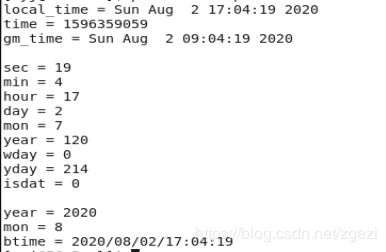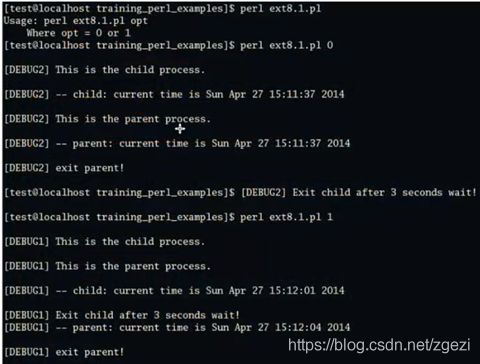Perl学习笔记(3)——控制结构/文件/排序/进程管理
Perl学习笔记(3)
- 一、控制结构
- 1.1 unless结构
- 1.2 until结构
- 1.3 elsif
- 1.4 ++/-\-
- 1.5 循环控制
- 1.6 " ? :" 操作符
- 1.7 逻辑操作符 :&& 、||
- 二、文件测试及目标操作
- 2.1 文件测试
- 2.1.1 文件测试操作符
- 2.1.2 stat和lstat函数
- 2.2 目标操作
- 2.2.1 在目录树中移动
- 2.2.2 文件名通配
- 2.2.3 目录句柄
- 2.2.4 删除文件
- 2.2.5 重命名文件
- 2.2.6 建立及删除目录
- 2.2.7 修改权限
- 2.2.8 修改隶属关系
- 2.2.9 修改时间戳
- 三、字符串与排序
- 3.1 在字符串内用index搜索
- 3.2 用substr处理子串
- 3.3 用sprintf格式化输出
- 3.4 高级排序
- 四、进程管理
- 4.1 system函数
- 4.2 exec函数
- 4.3 环境变量
- 4.4 使用反引号捕获输出结果
- 4.5 使用fork进行并发操作
一、控制结构
1.1 unless结构
当条件为假时,执行指定的语句:
my $fred = "45";
unless ($fred =~ /^[A-Z_]\w*$/i) {
print "\n[1]The value of \$fred doesn't look like a Perl identifier name.\n\n";
}
my $mon = "Feb";
unless ($mon =~ /^Feb/) {
print "[2]This month has at least thirty days.\n\n";
}
else {
print "[2]Do you see what's going on here?\n\n";
}
my $mon = "Mar";
unless ($mon =~ /^Feb/) {
print "[3]This month has at least thirty days.\n\n";
}
else {
print "[3]Do you see what's going on here?\n\n";
}
1.2 until结构
循环体一直执行,直到条件为真:
my $j = 1;
my $i = 20;
print "\n";
until ($j > $i) {
$j *= 2;
print "j = $j \n\n"
}
1.3 elsif
类似于verilog中的 else if
sim.log:
Compile rtl...
./simv update
# -----------------------------------------
# teststatus: failed
# failed_reason: check failed for y output
# -----------------------------------------
my $file = "sim.log";
print "\n";
open (LOG,"<",$file) or die "can not open $file for reading!\n";
while (defined (my $line = 1.4 ++/--
$i- - 先赋值后自减
$i++
- -$i
++$i
print "\n";
my $n = 0;
for (my $i = 0;$i <3 ; $i ++) {
print "i = $i ;\n";
}
print "-"x30 . "\n";
my $m = 5;
my $a = ++$m; #m=6
my $b = --$m; #m=5
my $c = $m++; #m=6 , c=5
my $d = $m--; #m=5 , c=6
print "a = $a ,b = $b ,c = $c,d = $d,m = $m;\n";
1.5 循环控制
循环控制用于佛for、foreach、while、until等循环;
- last
用于立刻终止当前循环,类似c中的break - next
结束当前这次循环的迭代,类似c中的continue - redo
控制返回到本次循环的顶端(开始next和redo者的最大区别在于next会正常继续下一次迭代,而redo则会重新执行这次的迭代。 - 带标签的块
将标签和一个冒号放在循环前而来创建带标签的循
环块;可使用标签从内层对外层循环块进行控制;last,next,redo后面可以接标签名。
my $file = "info.log";
open (LOG,"<",$file) or die "Can not open $file for reading!\n";
my $line_num = 0;
while (defined (my $line = 在phone那行没显示跳出本次循环,在version那行没显示,直接结束循环。

后一次last if 指定循环FOR_LOOP直接跳出,前一次则跳出所在循环。

1.6 " ? :" 操作符
- 语法:
expression ? if_ture_expr : if_false_expr
1.7 逻辑操作符 :&& 、||
for (1 .. 6) {
my $num = $_;
if ($num < 4 && $num >1) {
print "num = $num and this is the \"&&\"\n\n";
}
elsif ($num == 4 || $num == 6) {
print "num = $num and this is the \"||\"\n\n";
}
}
二、文件测试及目标操作
2.1 文件测试
2.1.1 文件测试操作符
my @files = qw(ext5.0.pl ext5.1.pl ext5.2.pl ext5.3.pl ext5.4.pl ext5.5.pl ext5.6.pl ext5.7.pl);
my @small_files;
print "\n";
foreach my $file (@files) {
if (! -e $file) {
print "$file does not exist in current dir \n\n";
}
elsif (-s $file < 100_000) {
push (@small_files, $file)
}
}
if (defined $small_files[0]) {
my $num = @small_files;
print "\nThe following $num files' size are samller than 100KB:\n";
print "-"x40 . "\n";
print "@small_files";
}
2.1.2 stat和lstat函数
- stat
返回和同名linux系统调用类似的文件信息(访问属性,用户编号及组ID,文件或目录的链接数,时间戳)
函数的参数可以是文件句柄或文件名。stat函数正常情况下会返回一个含有13个数字元素的列表,执行失败时返回空列表 - Istat
和stat函数类似,但它的参数必须是符号链接 - localtime
获得当前时间,和date效果一致 - gmtime
获得标准格林威治时间(英国标准时间,和北京时间相差人概8小时) - Time
返回值为一个整数,表示从XX年开始到现在时间的总秒数
my $local_time = localtime();
my $time = time();
my $gm_time = gmtime();
print "local_time = $local_time\n";
print "time = $time\n";
print "gm_time = $gm_time\n";
my ($sec,$min,$hour,$day,$mon,$year,$wday,$yday,$isdat) = localtime();
print "\nsec = $sec\n";
print "min = $min\n";
print "hour = $hour\n";
print "day = $day\n";
print "mon = $mon\n";
print "year = $year\n";
print "wday = $wday\n";
print "yday = $yday\n";
print "isdat = $isdat\n";
$year +=1900;
$mon += 1;
my $btime = sprintf ("%d/%02d/%02d/%02d:%02d:%02d",$year,$mon,$day,$hour,$min,$sec);
print "\nyear = $year \n";
print "mon = $mon\n";
print "btime = $btime\n";
2.2 目标操作
2.2.1 在目录树中移动
- chdir:该函数用于改变当前的工作目录
。由Perl程序启动的所有进程,都会继承Perl程序的工作目录
。对于启动Perl程序的进程,它的工作目录不会随Perl程序的工作目录的改变而改变
。chdir省略参数时,会回到用户的主目录
。一旦退出Perl程序,会回到开始的工作目录
2.2.2 文件名通配
- glob
能够在命令行上键入的模式,都可以作为glob的参数。如果需要一次匹配多种模式,可以在参数中用空格隔开各个模式。
my @all_files = golb"*"; #不含以点开始的文件
my @pm_files = glob "*.pm";
my @all_files_including_dot=glob ".**";
- < >
my $dir = "/etc"
my @dirfiles = <$dir/* $dir/.* >;
2.2.3 目录句柄
- opendir
打开文件句柄 - readdir
读取目录句柄的内容(读到的是目录里的文件名) - closedir
关闭目录句柄
my $dir = "./";
opendir DIR,$dir or die "Can not open $dir: $!";
print "\n";
foreach my $file (readdir DIR) {
if ($file eq ".") {
print "[WARN] -- current obtained file in $dir dir starts with \".\" and skip it \n";
}
elsif ($file eq "..") {
print "[WARN] -- current obtained file in $dir dir starts with \"..\" and skip it \n";
}
else {
print "[INFO] -- current obtained file in $dir dir is $file \n";
}
}
closedir DIR
2.2.4 删除文件
- unlink
unlink用于删除文件(而不能用来删除目录),它的返回值代表成功地删除了多少个文件
unlink "slate","bedrock","lava";
unlink glob "*.o";
2.2.5 重命名文件
- rename
重命名文件失败返回假
foreach my $file (glob "./logs/*.old") {
my $newfile = $file;
$newfile =~ s/\.old$/.new/;
if (-e $newfile) {
warn "can't rename $file to $newfile: $newfile exists\n";
}
elsif (rename $file,$newfile) {
print "rename $file to $newfile successfully!\n";
}
else {
print "rename $file to $newfile failed: &!\n";
}
}
2.2.6 建立及删除目录
- 新建目录
mkdir dir_name,permission
用oct函数把字符串表示的权限值转成八进制数字
mkdir sims,0755;#0755是八进制数
- 删除目录
rmdir dir_name;
。每次只能删除一个目录
。对非空的目录调用rmdir操作符会执行失败
。如何删除非空目录
unlink glob "$tmp_dir/* $tmp_dir/.*";
rmdir $tmpdir;
2.2.7 修改权限
- chmod
chmod 0755 FileA,FileB;
2.2.8 修改隶属关系
- chown
chown操作符会同时更改拥有者和所属组,必须以数字形式的用户标识符和组标识符来指定。getpwnam和getgrnam函数可以分别将用户名和组名翻译成数字。
my $user = 1004;
my $group =100;
chown $user,$group,glob "*.o";
defined (my $user = getpwnam "merlyn") or die "bad user";
defined (my $group = getpwnam "users") or die "bad groups";
chown $user,$group,glob "/home/merlyn/*";
2.2.9 修改时间戳
- utime
utime函数用于修改文件的访问时间和修改时间
utime access_time,modified_time,filelist;
my $now = time,
utime $now,$now,glob"*";
三、字符串与排序
3.1 在字符串内用index搜索
- index语法
index函数从$big字符串里寻找$small字符串首次出现的地方,返回一个整数代表第一个匹配字符的位置(从零开始)。如果没有找到子串,则返回-1
$where = index($big,$small);
or
$where = index($big,$small,$start_point);
- rindex搜索子串最后出现的位置
rindex可选的第三个参数用来限定返回的最大位置
my $stuff = "Howdy world!";
my $where = index ($stuff,"wor");
print "\n[INFO1] input string = \"$stuff\",where = $where \n\n";
my $where1 = index($stuff,"w"); #2
my $where2 = index($stuff,"w",$where1 + 1); #6
my $where3 = index($stuff,"w",$where2 + 1); #-1
print "\n[INFO2] input string = \"$stuff\",where1 = $where1, where2 = $where2, where3 = $where3 \n\n";
my $fred = "Yabba dabba doo!";
my $where1 = rindex($stuff,"abba"); #7
my $where2 = rindex($stuff,"abba",$where1 - 1); #1
my $where3 = rindex($stuff,"abba",$where2 - 1); #-1
print "\n[INFO3] input string = \"$stuff\",where1 = $where1, where2 = $where2, where3 = $where3 \n\n";
3.2 用substr处理子串
- 语法规则
substr操作符用于从一个长字符串中返回一个子串。$part=substr($string,$initial_position,$length);
当不指定第三个参数时,会一直取到字符串结尾。 - 起始位置可以为负值,表示从字符串结尾开始倒数
位置-1是最后一个字符,位置-3是从字符串结尾算起的第3个字符 - substr可以结合index—起使用
my $mineral = substr("Fred J. Flintstone",8,5); #gets "Flint"
my $rock = substr("Fred J. Flintstone",13,100); #gets "stone"
print "\n[INFO_1] mineral = \"$mineral\",rock = \"$rock\"\n\n";
my $pebble = substr("Fred J. Flintstone",13); #gets "stone"
my $out = substr("some very long string",-3,2); #gets "in"
print "[INFO_2] pebble = \"$pebble\",out = \"$out\"\n\n";
my $long = "some very very long string";
my $right = substr($long,index($long,"l")); #index 15
print "[INFO_3] long = \"$long\",right = \"$right\"\n\n";
my $string = "Hello world!";
substr($string,0,5) = "Goodbye";
print "[INFO_4] string = \"$string\"\n\n";
substr($string,0,7) =~ s/goodbye/ByeBye/ig;
print "[INFO_5] string = \"$string\"\n\n";
3.3 用sprintf格式化输出
- sprintf函数可以数据进行格式化,并返回处理过的字符串
my $year = "2020";
my $mon = "08";
my $day = "02";
my $hour = "19";
my $min = "32";
my $sec = "17";
my $date_tag = sprintf("%4d/%02d/%02d %2d:%02d:%02d",$year,$mon,$day,$hour,$min,$sec);
print "\n[INFO] date_tag = $date_tag \n\n";
# [INFO] date_tag = 2020/08/02 19:32:17
3.4 高级排序
- sort操作符以ASCII码序对列表进行排序
- Perl允许建立自己的排序规则了程序实现想要的排序方式
- 排序最终一定都是两两相比,因此排序子程序只要能比较两个元素就行
- 要使用排序子程序,只要把它的名字写在sort操作符和待排序的列表之间
my @result = sort by_number @items;
sub by_number {
if ($a < $b) {-1} elsif ($a > $b) {1} else {0};
}
- 三路数字比较操作符<=>
<=>操作符会比较两个数字并且返回-1,0或者1,好让它们与数字排序
。数值递增排序
sub by_number { $a <=> $b }
。数值递减排序
sub by_number { $b <=> $a }
。排序子程序中用到的变量$a和$b并不是数据项的拷贝,它们实际上是原始列表元素的临时化名,如果改变它们的话,会弄乱原始的数据 - 三路字符串比较操作符cmp
cmp操作符与sort的默认排序方法相同
my @strings = sort { $a cmp $b} @any—strings;
my @data_arrays = qw(4 2 10 23 7 40 30 20);
my @rise_arrays = sort {$a <=> $b} @data_arrays;
my @fall_arrays = sort {$b <=> $a} @data_arrays;
print "\n[INFO_0] data_arrays = @data_arrays\n";
print "[INFO_0] rise_arrays = @rise_arrays\n";
print "[INFO_0] fall_arrays = @fall_arrays\n";
my @str_arrays = qw(an good buy eggs cups);
my @rise_arrays = sort {$a cmp $b} @str_arrays;
my @fall_arrays = sort {$b cmp $a} @str_arrays;
print "\n[INFO_1] str_arrays = @str_arrays\n";
print "[INFO_1] rise_arrays = @rise_arrays\n";
print "[INFO_1] fall_arrays = @fall_arrays\n";
四、进程管理
4.1 system函数
- system函数是启动Perl子进程最简单的方法
e.g.:system "date"
上述例子会创建一个子进程来运行date命令,并且它继承了Perl的标准输入输出。
e.g.:system 'ls -l $HOME';#单引号防止变量内插 - 可以利用shell功能来启动后台进程
e.g.:system "run_cmd with parameters &"; - system执行正常返回值为0,否则返回值为非0
!system "rm -r files" or die "operation wrong" - system支持多个参数
第一个参数’‘tar’'是命令名称,后面的参数会被逐项的传递给前面的命令,即使参数里出现对shell有意义的字符(如星号*,管道符号,大小于号以及与号)都不会被shell误解为特殊含义。
my $tarfile = "something*wicked.tar"
my @dirs = qw(fred|flint bet) :
system "tar","cvf",$tarfile,@dirs;#三个待打包目录
如果不采用多参数形式,而采用如下的形式,shell会扩展目录名称@dirs中的特殊字符,造成意想不到的结果:
system "tar cvf $tarfile @dirs";
4.2 exec函数
效果同system类似,用于执行外部命令。system会创建子进程执行外部命令,父进程等待创建的子进程结束并继续执行下而的代码。exec不会开启子进程,而是取代父进程,因此执行完引号中的命令后进程即结束。一般和fork配合使用。
exec调用之后写的任何代码都无法运行
- 如果确定不了到底要用system还是exec,就用system,大多数情况下都是稳妥的
Example:
chdir "/tmp" or die "Cannot chdir/tmp:$!";
exec "bedrock","-o","args1",@ARGV;
4.3 环境变量
- 环境变量对应于特殊的%ENV哈希,每个键代表一个环境变量
- 程序开始运行时,%ENV会保留从父进程(通常为shell)继承来的设定值
- 修改%ENV就能改变环境变量,并能被Perl调用的子进程继承
$ENV{'PATH'} = "/home/usra/bin:$ENV{'PATH'}";
- 修改从父进程继承的变量并不影响sh刨或其他父进程
4.4 使用反引号捕获输出结果
- system和exec调用外部程序的输出会定向到标准输出
- 使用反引号调用外部命令可以捕获被调用程序的输出
my $now = `date`;
- 使用反引号时反斜线转义和变量内插都会正常处理
- 使用反引号调用命令时按行返回且每行结束带一个回车
4.5 使用fork进行并发操作
fork用于从一个进程中创建两个进程。如果它成功,该函数给父进程返回新创建的子进程ID,而给子进程返回0。如果系统没有足够的资源分配一个新的进程,那么调用失败并返回undefo
父进程可以使用waitpid函数等待子进程的结束。
my $opt = 0;
my $localtime;
if (@ARGV > 0) {
$opt = $ARGV[0];
}
else {
print "Usage: perl $0 opt \n";
print " Where opt = 0 or 1 \n";
exit;
}
if ($opt == 1) {
defined (my $pid = fork()) or die "Fork process failured:$!\n";
unless ($pid) {
print "\n[DEBUG1] This is the child process.\n\n";
$localtime = localtime();
print "[DEBUG1] -- child:current time is $localtime \n\n";
sleep(3);
print "[DEBUG1] Exit child after 3seconds wait!\n";
exit();
}
print "[DEBUG1] This is the parent process.\n\n";
waitpid($pid,0);
$localtime = localtime();
print "[DEBUG1] -- parent:current time is $localtime \n\n";
print "[DEBUG1] exit parent!\n\n";
}
else {
defined (my $pid1 = fork()) or die "Fork process failured:$!\n";
unless ($pid1) {
print "\n[DEBUG2] This is the child process.\n\n";
$localtime = localtime();
print "[DEBUG2] -- child:current time is $localtime \n\n";
sleep(3);
print "[DEBUG2] Exit child after 3seconds wait!\n";
exit();
}
print "[DEBUG2] This is the parent process.\n\n";
$localtime = localtime();
print "[DEBUG2] -- parent:current time is $localtime \n\n";
print ("[DEBUG2] exit parent!\n\n");
}














